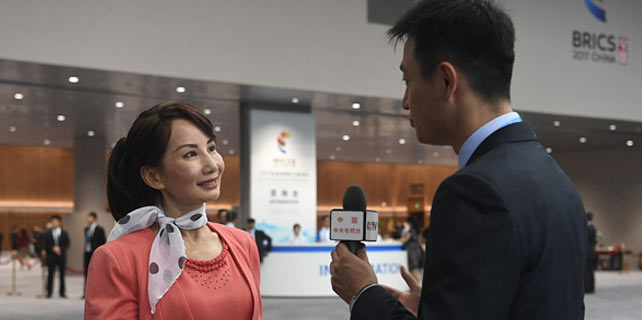A force to be reckoned with

After more than a decade since its first edition, the Shanghai Fashion Week has matured to become a key driving force for not just Chinese designers but the city's economic growth as well
When the latest edition of the Shanghai Fashion Week (SHFW), which took place from Oct 11 to 18, came to end, many local designers were left smiling at the bulk of orders they had received.
According to Lyu Xiaolei, deputy secretary-general of SHFW, the number of orders received at Mode Shanghai, the major trade platform for the annual fashion event, saw a significant increase this year. The average value of each order in this edition was 300,000 yuan ($45,249) and 30 percent of them came from overseas buyers.
"Brands participating in the fashion week used to ask one another if they received any orders," said Lyu. "These days, they're asking each other how large their orders are.
"It can be seen that the trading relationship, as well as the supply-demand relationship, has achieved a sustained and stable growth. SHFW will be looking to create deeper connections between exhibitors and professional audiences."
One of the ways SHFW connects designers with buyers is through showrooms, which are ideal for small brands that don't have as much financial muscle as the big players. Such spaces are seen as effective means to gain maximum publicity without having to spend a fortune.
According to the organizers, there were 33 showrooms set up at this year's fashion week, eight more than the last edition. Zhang Ying, founder of Not Showroom, said that the number of visitors to her showroom was significantly higher this year, and this resulted in a spike in orders.
The local government had as early as 1999 established the Shanghai International Fashion Center which would become a platform to launch a fashion festival. According to Lyu, who was a part of the team that helped prepare for this festival, the initial focus was largely on inviting famous designers and models, which she knew would do little to advance China's fashion industry.
As such, she initiated the idea of a fashion week which first came into being in 2003. Lyu added that this event has since been recognized as an important part of the city's strategy to transform itself into an international trade center, and its importance is highlighted by the grants it receives from the Ministry of Commerce and the municipal government.
Zhou Lan, director of the market system department of Shanghai Municipal Commission of Commerce, noted that the flurry of trade activity at this year's SHFW indicates that the fashion industry has become a key driver in the city's quest for commercial reform.

According to public information, Shanghai contributed to 30 percent of the total port trade volume and 25 percent of the total service volume in China last year. The turnover of the city's wholesale and retail industry exceeded 10 trillion yuan and 1 trillion yuan respectively.
Zhou pointed out that the sales revenue of clothing and shoes accounted for 20 percent of Shanghai's total retail turnover last year.
"All these achievements are linked to the contributions of the fashion industry," she said.
"We have also noticed that department stores like Lane Crawford and K11 in downtown Shanghai have registered a 20 percent year-on-year growth in turnover this year."
Zhou added that the government will continue to lend its full support to the development of the Shanghai fashion industry by connecting research and development, design, marketing, releasing and promotion.
"The municipal government and related ministries in the country will work together to achieve sustainable growth for the fashion industry in Shanghai and all over China," she said.
The growth in sales also indicate that Chinese designers are getting increasingly noticed around the world. This year, Italian luxury online marketplace Luisa via Roma attended SHFW for the first time and the company's chief executive officer Andrea Panconesi said the purpose of his trip was to scout for more Chinese brands. Creations by Chinese designers currently account for up to 8 percent of the products available on Luisa via Roma.
"The collections at SHFW are younger but the idea is the same as the international market, which is to cater to different groups of audiences and attract more young audiences," he said.
"One of the best things of SHFW is the various trade shows. I will bring more Chinese brands into Luisa via Roma after this year's SHFW."
Terence Chu, founder of APAX Group, the organizer of SHFW, noted that the fashion week has, on the other hand, also successfully promoted foreign brands to Chinese consumers.
"Over time, we have seen a sizeable number of Chinese brands entering overseas market via SHFW. Meanwhile, overseas brands have also gained considerable presence during the SHFW over the past three years," he said.
This two-way flow of brands, added Chu, is a key focus of SHFW and is also prevalent in mature fashion markets such as the United States.
Zhou said that the continued development of Shanghai's fashion industry could also positively impact the upgrading of department stores as well.
Starting in the 1990s, department stores were the go-to shopping venues for Shanghai residents. However, the emergence of shopping malls across the city saw their popularity dip.
According to research, revenues at China's department stores declined from 1.01 trillion yuan in 2014 to 994 billion yuan last year. Euromonitor International predicted that the figure will further slip to 904 billion yuan by 2021.
"Department stores in Shanghai used to focus on leasing only. Their ability in managing products and brands is really poor," said Zhou.
"It is prime time for them to change at a time of economic transformation and the management of fashion brands can be an ideal breakthrough."
He Qi in Shanghai contributed to this story.
shijing@chinadaily.com.cn









